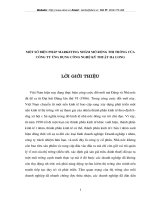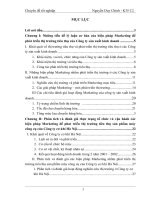Case study LEVIS for Marketing Management
Bạn đang xem bản rút gọn của tài liệu. Xem và tải ngay bản đầy đủ của tài liệu tại đây (212.65 KB, 2 trang )
EVEN LEVI’S CAN MAKE MISTAKES
CONCEPTS NEEDED Market research. Marketing model
During the 1980s, Levi‟s U.S division was
looking at ways of diversifying away from
its heavy dependence on a jeans market that
appeared to be saturated. They had already
introduced Levi‟s shoes, shirts and socks,
which sold quite well among people who
were already buying Levi jeans. Now they
wanted to move into the market for higher
priced clothes, in order to attract a new type
of customer to the Levi Strauss brand. As
menswear had always been their biggest
seller, it was decider to concentrate on the
male market first.
To decide how to meet this objective, a
market research company was commissioned
to investigate men‟s purchasing habits and
attitudes to clothes (a Usage and Attitudes
study). A large quantitative survey was
conducted among a quota of 2,000 men who
had recently spent at least $50 on clothing.
When analyzed, the survey revealed that the
entire menswear market could be segmented
into five types of buyer:
Type 1: Traditionalist (probably over
45; department store shopper, buys
polyester suits and slacks, shops with
wife)
Type 2: Classic Independent (a real
clothes horse; 21% of market, yet
buying 46% of wool blend suits,
buys at independent stores; expensive
tastes)
Type 3: Utilitarian (wears jeans for
work and play; 26% of the market;
Levi loyalists)
Type 4: Trendy Casual (buying
„designer‟, high fashion clothes,
might buy 501s, but usually
considers Levi too mass- market;
19% of the market)
Type 5: Price Shopper (buys
whatever and wherever the lowest
prices are found; no potential for
Levi; 14% of market)
As the Type 2 Classic Independent
men fitted in with Levi‟s objective, the
research company was asked to
computer analyze the findings so that the
behavior and attitudes of this specific
group could be split out from the rest of
the sample. The large total number of
interviews made it possible to have
confidence in the reliability of the data
from this sub- sample. It emerged that
Type 2 men wanted traditionally styled,
perhaps pin- striped, suit; that they like
to buy through independent clothes
shops or tailors, rather than at
department stores, and that they liked to
shop alone, whereas others liked having
their wife/ girlfriend with them.
Classic Independent
21%
Traditionalist
20%
Utilitarian
26%
Price Shopper
14%
Trendy Casual
19%
To tackle this segment of the market, Levi‟s
decided to introduce „Tailored Classics‟ a
range of high quality wool suits, trousers and
jackets. The research showed that these
buyers valued quality and fit rather than low
prices, so they decided to price their range
10% above that of the competition. To avoid
direct product comparisons and to ensure
that not too large a sales force was needed,
Levi chose to distribute through department
store chains.
Having decides on this strategy, its
acceptability to the target market was tested
via a series of group discussion. These were
conducted by a psychologist who was to
look for the real motivations behinds
respondents‟ opinions or behavior. The
psychologist reported that the Type 2 men
had two misgivings: first they were
concerned that the garments would be in
standard fittings, and so would not provided
the tailoring they wanted; second, although
they could believe that Levi‟s could make a
good suit, they still felt uncomfortable about
the Levi‟s name. One said:
“When I think Levi think jeans. If they‟re
making suits I have to be convinced”
Another felt that:
“If I went to work and someone said: Hey,
that‟s a good suit, Joe, who‟s it by? I
wouldn‟t feel comfortable saying Levi”
The company‟s marketing executives
responded to this by deciding to concentrate
on the separate jackets and trousers in the
launch
advertising,
and
let
suits
“slipstream”. The Director of Consumer
Marketing felt certain that:
“The thing that‟s going to overcome Levi‟s
image for casualness as no other thing can, is
a suit that‟s made by Levi that doesn‟t look
like all the other things we‟ve made. Once
that gets on the image that says: Oh, and
they can also make a good suit when they
put their mind to it”.
Soon after this decision, salesmen started
contacting retail buyers. After four months
of selling to the trade, it was clear that the
range‟s sales targets would not be met. Even
a price cut did little to redeem the situation
and Tailored Classics achieved only 65% of
its modest sales targets.
Levi‟s could only find consolation if they
could learn why they went so badly wrong.
Sources: Channel 4: “Commercial Breaks”; The Financial Times







